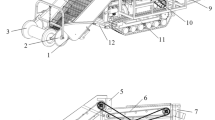Abstract
Transportation costs for cull potato solids can be reduced by removing liquid with a pressure process if the potato cell walls are disintegrated. A small rod mill was built and evaluated for grinding potatoes. The particle size distribution of the output from the mill was analysed to measure the ability to disintegrate cell walls of potatoes. Ten minutes of grinding was sufficient to produce a satisfactory product distribution range and facilitated the release of a large portion of free liquid. After six minutes of grinding, there were no further significant changes with time in the distribution of particles smaller than 180 m. No further particle grinding or cell disintegration occurred within this size range. Work to define parameters such as potato size, drum diameter and rod size could lead to using these mills to produce a slurry. This slurry could then be filtered to produce a crude starch cake suitable for storage, transportation, and further purification.
Compendio
Los costos de transporte de los sólidos extraídos de la papa se pueden reducir mediante la remoción, a presión, de los líquidos si se desintegran las paredes celulares de la papa. Se construyó y evaluó un pequeño molino de rodillo, para moler papas. Se analizó la distribución del tamaño de las partículas que salían del molino con la fmalidad de medir su habilidad para desintegrar las paredes celulares de las papas. Diez minutos de molienda fueron suficientes para producir un rango satisfactorio de distribución del producto y facilitar la liberatión de gran parte del líquido libre. Después de seis minutos de molienda no hubo cambios significativos adicionales con el tiempo en la distribución de partículas menores de 180 ¼. Dentro de este rango no se presentaron molienda de partículas o desintegración celular adicionales. El trabajo para definir parämetros tales como el tamafño de la papa, diametro del cilindro y tamafño del rodillo, podría permitir el uso de estos molinos para producir una mezcla acuosa de sólidos que podría ser luego filtrada para producir una masa compacta de almidón crudo adecuada para el almacenamiento, transporte y posterior purificación.
Similar content being viewed by others
Literature Cited
Nicholson, J.W.G. 1974. Guidelines For Feeding Potato Processing Wastes and Culls to Cattle. Publication No. 1527 Agriculture Canada, Ottawa K1A 0C7.
Perry, R.H. and C.H. Hilton. 1973. Chemical Engineers Handbook. Fifth Edition. McGraw-Hill Book Company, New York, New York.
Smith O. Potatoes. 1977. Production, Storing, and Processing. Second Edition. AVI Publishing Company Inc., Westport Connecticut.
Author information
Authors and Affiliations
Rights and permissions
About this article
Cite this article
McLeod, C.D., Misener, G.C. Short Communication. American Potato Journal 67, 245–250 (1990). https://doi.org/10.1007/BF02987266
Accepted:
Issue Date:
DOI: https://doi.org/10.1007/BF02987266




